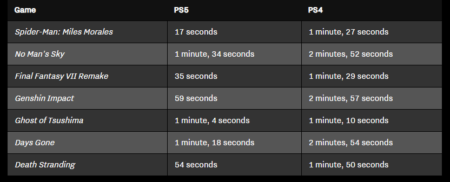The new console generation really is different this time. I’ve long been  interested in how video game consoles have – at least since the Nintendo 64 – consistently been promoted on the promise that now, graphics were being revolutionized and we would finally be able to play video games that were “just like movies”.
interested in how video game consoles have – at least since the Nintendo 64 – consistently been promoted on the promise that now, graphics were being revolutionized and we would finally be able to play video games that were “just like movies”.
With the PlayStation 5 and Xbox Series S|X, the main story is a different one: load times. For example, The Verge’s PlayStation 5 review lists “Games load quickly and run smoothly” as a top positive point, and features a table comparing load times, but graphical capabilities are a bit more theoretical – do you have a 4K TV?

The Xbox Series S|X get a similar treatment, with load times getting top billing in the Verge review. It is definitely becoming harder for non-experts to tell console generations apart graphically.
Sony and Microsoft are actually catching up to Nintendo here. Where Xbox One and PlayStation 4 were in many ways painful hells of just-wait-30-minutes-for-the-update-before-playing, one of the selling points of the Nintendo Switch really was the near-instantaneous launch times, and instant sleep and wake from sleep.
Interestingly, this comes at a time where the game industry at large has begun to talk of “quality of life updates” – the kind of update that doesn’t add features, but just removes some time management or other hassles from the player. The primary barrier to playing is almost always time, and the PlayStation 5 focus on activities is a way for a console to compete with the bite-sized chunks of playtime that we get for free on our phones, but which have been hard to come by on consoles.
Generic Hardware for Unique Experiences
 The other apparent thing now is the sheer genericness of the hardware. The Xbox and PlayStations are now both just boxes of ever-so-slightly modified generic PC components, AMD RDNA 2 CPU and GPU, SSD and so on. I think this correlates with a de-emphasizing of console generations, with a larger expectation of backwards compatibility and mid-generation updates (PS4 Pro, Xbox One S|X).
The other apparent thing now is the sheer genericness of the hardware. The Xbox and PlayStations are now both just boxes of ever-so-slightly modified generic PC components, AMD RDNA 2 CPU and GPU, SSD and so on. I think this correlates with a de-emphasizing of console generations, with a larger expectation of backwards compatibility and mid-generation updates (PS4 Pro, Xbox One S|X).
In parallel, the commodification of phone hardware means that the Switch is basically the hardware of large Android phone.
So it’s a pragmatic generation, one of making-do, not of flashy new graphics, not of fancy new technology. It’s just a generation of casualization, of making games fit better into people’s lives.




